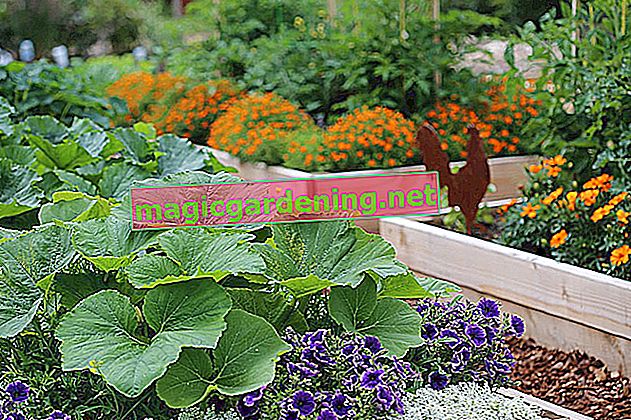
How do good neighbors benefit from each other?
There are a number of reasons in favor of certain plant neighborhoods:
- Pests do not like the smell of the neighboring plant and therefore stay away.
- Beneficial animals are attracted.
- Neighboring plants attract insects and thus ensure good pollination and a richer harvest.
- Sensitive plants are shaded by tall, sun-hungry plants.
- The space in the bed is optimally used.
- Better use of nutrients in the soil.
also read
- Mixed culture - good neighbors in the vegetable patch
- What fits together? Good neighbors in the vegetable garden
- A prosperous neighborhood in the vegetable garden thanks to mixed culture
Which plants should be placed next to each other?
“Even the strongest of plants cannot thrive if the neighbor doesn't like it.” One could modify Schiller’s quote like this or something like that, it’s about the vegetable patch. The following table provides information on which vegetable plants thrive when placed next to each other:
| plant | good neighbors | bad neighbors |
|---|---|---|
| Beans | Savory, strawberries, cucumber, potatoes, cabbage, lettuce and lettuce, celery, beetroot, tomatoes | Peas, fennel, garlic, leek, onions |
| Strawberries | French beans, garlic, lettuce, leek, radishes, chives, spinach, onions | Cabbage |
| Potatoes | Broad beans, chamomile, nasturtiums, cabbage, caraway seeds, corn, horseradish, mint, spinach, marigolds | Pumpkin, tomato, celery, sunflower |
| leek | Endive, strawberries, chamomile, cabbage, lettuce, carrots, black salsify, celery, tomatoes | Beans, peas, beetroot |
| Corn | Beans, cucumber, potatoes, lettuce, pumpkin, melons, tomatoes, zucchini | Beetroot, celery |
| Carrots | Dill, peas, garlic, leek, Swiss chard, radish, radish, rosemary, sage, chives, lettuce, salsify, tomatoes, onions | |
| Radish and radish | Beans, peas, nasturtiums, cabbage, lettuce, Swiss chard, carrots, spinach, tomatoes | Cucumbers |
| celery | French beans, cucumber, chamomile, cabbage, leek, tomato | Potatoes, lettuce, corn |
| asparagus | Cucumber, lettuce, parsley, lettuce, tomatoes | Garlic, onions |
| spinach | Strawberries, potatoes, cabbage, radishes, radish, celery, runner beans, tomatoes | |
| tomatoes | French beans, nasturtiums, garlic, cabbage, lettuce, leek, corn, carrots, parsley, lettuce, radishes, radish, beetroot, celery, spinach | Peas, fennel, potatoes |
| zucchini | Nasturtiums, corn, beetroot, runner beans, onions | |
| Onions | Savory, dill, strawberries, cucumber, chamomile, lettuce, carrots, beetroot, black salsify | Beans, peas, cabbage |
Many more plants could be found that harmonize very well. You can find extensive tables in gardening shops.
Which neighbors are particularly unfavorable?
There are some plants that you absolutely shouldn't put next to each other:
- Lettuce and parsley
- Fennel and tomatoes
- French beans and onions
- Cabbage and onions
- Tomatoes and peas
- Peas and beans
- Potatoes and sunflowers
- Potatoes and tomatoes
Tips
If you look at different sources, the information about good and bad neighbors does not always match. This depends on the soil and location, but also on the choice of variety. Therefore, note down your own observations and include your own experiences in the planting plan for the next garden year.







